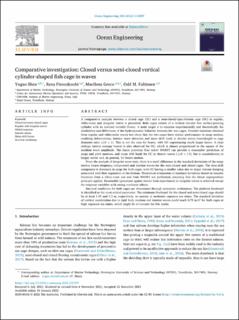| dc.contributor.author | Shen, Yugao | |
| dc.contributor.author | Firoozkoohi, Reza | |
| dc.contributor.author | Greco, Marilena | |
| dc.contributor.author | Faltinsen, Odd Magnus | |
| dc.date.accessioned | 2023-01-01T14:20:49Z | |
| dc.date.available | 2023-01-01T14:20:49Z | |
| dc.date.created | 2022-02-10T12:03:28Z | |
| dc.date.issued | 2022 | |
| dc.identifier.citation | Ocean Engineering. 2022, 245 1-23. | en_US |
| dc.identifier.issn | 0029-8018 | |
| dc.identifier.uri | https://hdl.handle.net/11250/3040146 | |
| dc.description.abstract | A comparative analysis between a closed cage (CC) and a semi-closed/open-bottom cage (OC) in regular, white-noise and irregular waves is presented. Both cages consist of a vertical circular free surface-piercing cylinder with an external toroidal floater. A main target is to examine experimentally and theoretically the similarities and differences of the hydrodynamic behavior between the two cages. Transfer functions obtained from regular and white-noise waves test show that the two cages have similar performance in surge motion, ovalizing deformations, interior wave elevation and mean drift loads in shorter waves (wavelength to cage diameter ratio ). This is not the case for heave, with OC experiencing much larger heave. A clear sinkage (minus average heave) is also observed for OC, which is almost proportional to the square of the incident wave amplitude. The linear potential flow solver WAMIT can provide a reasonable prediction of surge and pitch motions, and mean drift loads for OC in shorter waves (), but is unsatisfactory in longer waves and, in general, for heave motion.
From the analysis of irregular wave tests, there is a small difference in the standard deviations of the surge motion (wave-frequency component) and interior waves for the semi-closed and closed cages. The slow-drift component is dominant in surge for both cages, with OC having a smaller value due to larger viscous damping associated with flow separation at the bottom. Theoretical evaluations of standard deviations based on transfer functions from a white-noise test and from WAMIT are performed, assuming that the linear superposition principle applies. Reasonable agreement against results from experiments in irregular waves is achieved except for response variables with strong nonlinear effects.
Survival conditions for both cages are determined through systematic evaluations. The platform freeboard is identified as the most critical parameter. The minimum freeboard for the closed and semi-closed cage should be at least 1.05 and 1.3 m, respectively, to operate at moderate exposure sea states. The standard deviation of vertical acceleration due to rigid body motions and interior waves could reach 0.72 m/s2 for both cages at high exposure sea states, which might be of concern for fish inside. | en_US |
| dc.language.iso | eng | en_US |
| dc.publisher | Elsevier | en_US |
| dc.rights | Navngivelse 4.0 Internasjonal | * |
| dc.rights.uri | http://creativecommons.org/licenses/by/4.0/deed.no | * |
| dc.title | Comparative investigation: Closed versus semi-closed vertical cylinder-shaped fish cage in waves | en_US |
| dc.title.alternative | Comparative investigation: Closed versus semi-closed vertical cylinder-shaped fish cage in waves | en_US |
| dc.type | Journal article | en_US |
| dc.type | Peer reviewed | en_US |
| dc.description.version | publishedVersion | en_US |
| dc.source.pagenumber | 1-23 | en_US |
| dc.source.volume | 245 | en_US |
| dc.source.journal | Ocean Engineering | en_US |
| dc.identifier.doi | 10.1016/j.oceaneng.2021.110397 | |
| dc.identifier.cristin | 1999916 | |
| dc.relation.project | Norges forskningsråd: 309281 | en_US |
| cristin.ispublished | true | |
| cristin.fulltext | original | |
| cristin.qualitycode | 1 | |

